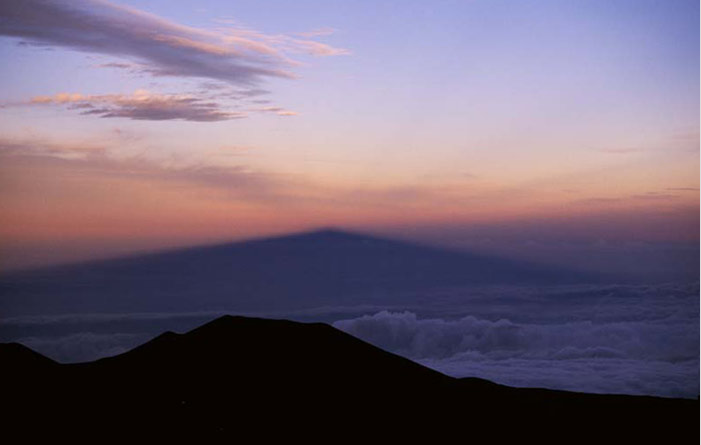Mauna Kea Shadow I
Mauna Kea Shadow I: A Captivating Atmospheric Phenomenon
Have you ever witnessed a shadow so intriguing that it leaves you in awe? Josh Vaughan, an observer from Arizona, had the privilege of witnessing a mesmerizing triangular shadow while standing atop Mauna Kea, the highest peak of the Hawaiian Islands, reaching an impressive elevation of 4205m (13,800ft). Although the peak itself has a roughly triangular shape, the captivating angular shadow owes its appearance more to the magic of perspective.
As we gaze upon the image captured by Josh Vaughan, we are transported to a realm where nature's wonders unfold before our eyes. The triangular shadow, cast through the air, captivates our imagination and invites us to delve deeper into the mysteries of atmospheric optics.
In the sky above, faint anticrepuscular rays gracefully radiate from the antisolar point, which is marked by the tip of the mountain shadow. These ethereal rays add a touch of ethereal beauty to the already enchanting scene. Anticrepuscular rays are a captivating atmospheric phenomenon where sunlight appears to converge towards a point opposite the sun, creating a mesmerizing display of light and shadow.
The unique perspective created by the triangular shape of the shadow showcases the fascinating interplay between light and matter in our atmosphere. This phenomenon reminds us of the intricate dance between the sun's rays and Earth's topography, which can give rise to breathtaking optical illusions.
While this article has been automatically converted from the old site and may not appear as intended, we are fortunate to witness this captivating image that allows us to delve into the intricacies of Mauna Kea's shadow phenomenon. Let us embark on a journey to explore the scientific principles behind this enchanting spectacle.
The Science Behind Mauna Kea's Triangular Shadow
The triangular shape of Mauna Kea's shadow is a result of perspective. When sunlight interacts with the mountain, it casts a shadow that appears to converge towards a point on the horizon. This convergence is due to the vast distance between the observer and the mountain, creating a visual effect where the shadow seems to narrow as it extends into the distance.
Atmospheric Optics: A World of Wonders
Atmospheric optics is a branch of science that explores the fascinating interaction between light and the Earth's atmosphere. It encompasses a wide array of optical phenomena that occur due to the complex interplay between sunlight, atmospheric particles, and various atmospheric conditions.
Within this realm of atmospheric optics, we encounter an astonishing array of captivating phenomena. From the shimmering beauty of rainbows to the mesmerizing dance of auroras, these phenomena offer glimpses into the intricate workings of our atmosphere.
Anticrepuscular Rays: A Heavenly Display
The faint anticrepuscular rays visible in the sky above Mauna Kea's shadow add an extra layer of enchantment to the scene. These rays are a captivating optical illusion created by the convergence of sunlight in the opposite direction of the sun. As the sun's rays scatter and interact with atmospheric particles, they create a stunning display that appears to radiate from a point opposite the sun.
Exploring Mauna Kea: A Haven for Observers
Mauna Kea, renowned for its astronomical observatories, offers a unique vantage point for observing atmospheric phenomena. Its impressive elevation and strategic location provide an ideal platform for witnessing captivating displays like the triangular shadow and anticrepuscular rays.
Unraveling Nature's Secrets: Observing Atmospheric Optics
Witnessing captivating atmospheric phenomena like Mauna Kea's shadow invites us to explore the mysteries of our natural world. By observing and studying these optical illusions, scientists can gain valuable insights into the behavior of light and its interaction with Earth's atmosphere. Through careful observation and analysis, we can uncover hidden truths and expand our understanding of the intricate workings of our planet.
Inspiring Wonder: A Glimpse into Nature's Artistry
The beauty and complexity of atmospheric optics serve as a reminder of the awe-inspiring wonders that surround us. From the grandeur of mountain shadows to the delicate hues of a rainbow, these phenomena showcase nature's artistry and captivate our imagination. They inspire us to delve deeper into the mysteries of our world and appreciate the intricate beauty that lies just beyond our reach.
In conclusion, Mauna Kea's triangular shadow, as witnessed by Josh Vaughan, is a captivating testament to the interplay between light, matter, and perspective. This phenomenon, coupled with the faint anticrepuscular rays radiating from the antisolar point, transports us to a realm where nature's artistry unfolds before our eyes. As we delve into the intricacies of atmospheric optics, we gain a deeper appreciation for the wonders that surround us and the mysteries waiting to be unraveled. Let us continue to marvel at the enchanting dance of light and shadow that paints the canvas of our atmosphere.

Josh Vaughan of Arizona saw this incredible triangular shadow from the top of Mauna Kea, 4205m (13,800ft), the highest peak of the Hawaiian Islands. The peak has a roughly triangular shape but the shadow cast through the air owes its angular shape more to perspective. In the sky, faint anticrepuscular rays radiate from the antisolar point marked by the mountain shadow's tip. Image @Josh vaughan, shown with permission.

Note: this article has been automatically converted from the old site and may not appear as intended. You can find the original article here.
Reference Atmospheric Optics
If you use any of the definitions, information, or data presented on Atmospheric Optics, please copy the link or reference below to properly credit us as the reference source. Thank you!
-
<a href="https://atoptics.co.uk/blog/mauna-kea-shadow-i/">Mauna Kea Shadow I</a>
-
"Mauna Kea Shadow I". Atmospheric Optics. Accessed on November 26, 2024. https://atoptics.co.uk/blog/mauna-kea-shadow-i/.
-
"Mauna Kea Shadow I". Atmospheric Optics, https://atoptics.co.uk/blog/mauna-kea-shadow-i/. Accessed 26 November, 2024
-
Mauna Kea Shadow I. Atmospheric Optics. Retrieved from https://atoptics.co.uk/blog/mauna-kea-shadow-i/.